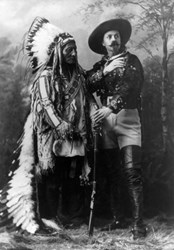New NativeAmericanChiefs.org features essays, photos of legendary Native American chiefs.
 Source: PRWeb
Source: PRWeb
Native American chiefs are supremely honored, and hold the highest position within individual Native American tribes. Before generals and politicians ruled the land, the United States was filled with indigenous Native American tribes, and was host to many small societies existing beneath chiefdom.
In Native American culture, an elder was considered to be the wisest. Elders were thought to deliver just decisions, and often rose to the rank of chief. Native American chiefs have accomplished many important feats for Native Americans, and have been recorded within American history.
Now, a new website dedicated to legendary Native American chiefs has been launched.
“Many Native American chiefs have been regarded as great warriors, and have spearheaded campaigns to protect their people from danger at overwhelming odds,” said NativeAmericanChiefs.org spokesperson James Heldon. “Chiefs have led entire civilizations, expelled enemy occupants and have led tribes into profitable lands, filled with hunting grounds and fertile soil.”
The Native American leader, Geronimo, was an Apache warrior who fought the United States and Mexico to protect his people’s land. His father-in-law, Chief Cochise, was considered a fearsome warrior, and spent much of his life at war with Mexican forces to protect his tribe’s culture.
The Navajo chief, Manuelito, evaded capture by American forces in the 1800s, and additionally led his people into battle against overwhelming odds against the American Army. He took part in several battles, and participated in the Long Walk, where the United States forced the Navajo tribe to walk—at gunpoint—from their Arizona reservation to eastern New Mexico.
The Sioux chief, Sitting Bull, is arguably the most famous Native American leader. He’s considered a figure of deep conviction, cunning and bravery, and led his people to a decisive victory against opposing forces during the Battle of Little Bighorn. The Sioux, themselves, were fierce combatants, and entered battle with traditional war shirts, decorated with human scalps and ceremonial beads. Camouflage wasn’t used, as war garments were worn to inspire fear within the enemy. A chief normally stuck out, and was decorated with elaborate clothing and jewelry.
“The many stories of Native American chiefs are passed down through history, and tribes keep them alive—even today,” said Heldon. “Their tales of bravery and heroism are inspiring legends, and will likely exist for centuries. Chiefs have historically led their tribes through struggles, famine and war, and continue to lead modern tribes through hardships.”
To learn more information about Indian chiefs, as well as their accomplishments, take a look at NativeAmericanChiefs.org. Visitors will encounter stories of battles, and access biographical information pertaining to Native American leaders.
